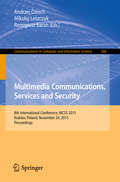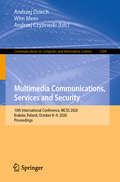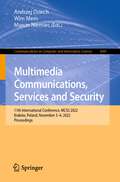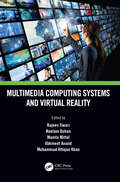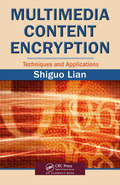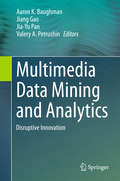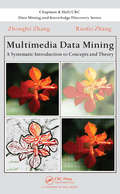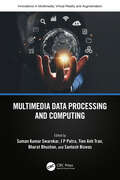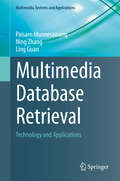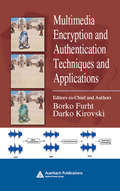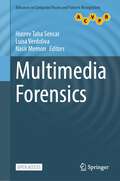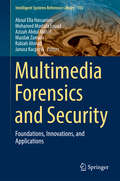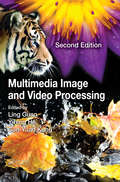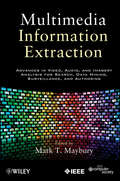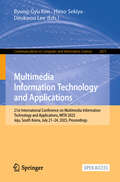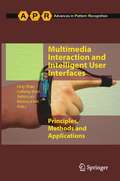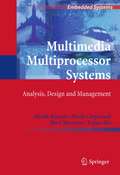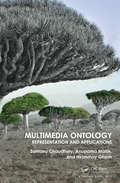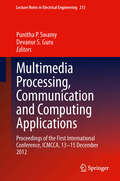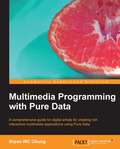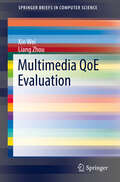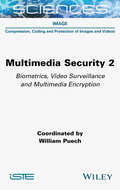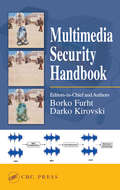- Table View
- List View
Multimedia Communications, Services and Security
by Andrzej Dziech Mikołaj Leszczuk Remigiusz BaranThis volume constitutes the refereed proceedings of the 8th International Conference on Multimedia Communications, Services and Security, MCSS 2015, held in Krakow, Poland, in November 2015. The 16 full papers included in the volume were selected from 39 submissions. The papers cover ongoing research activities in the following topics: multimedia services; intelligent monitoring; audio-visual systems; biometric applications; experiments and deployments.
Multimedia Communications, Services and Security: 10th International Conference, MCSS 2020, Kraków, Poland, October 8-9, 2020, Proceedings (Communications in Computer and Information Science #1284)
by Andrzej Dziech Andrzej Czyżewski Wim MeesThis volume constitutes the refereed proceedings of the 10th International Conference on Multimedia Communications, Services and Security, MCSS 2020, held in Kraków, Poland, in October 2020. The 24 full papers and 2 short papers included in the volume were selected from 54 submissions. The papers cover ongoing research activities in the following topics: multimedia services; intelligent monitoring; audio-visual systems; biometric applications; experiments and deployments.
Multimedia Communications, Services and Security: 11th International Conference, MCSS 2022, Kraków, Poland, November 3–4, 2022, Proceedings (Communications in Computer and Information Science #1689)
by Andrzej Dziech Wim Mees Marcin NiemiecThis book constitutes the proceedings of the 11th International Conference, MCSS 2022, held in Kraków, Poland, during November 3–4, 2022. The 13 full papers included in this book were carefully reviewed and selected from 33 submissions. The papers cover ongoing research activities in the following topics: cybersecurity, multimedia services; intelligent monitoring; audio-visual systems; biometric applications; experiments and deployments.
Multimedia Computing
by Gerald Friedland Ramesh JainThe word 'multimedia' is often associated with specific applications from entertainment to web design to video to music. This innovative textbook presents emerging techniques in multimedia computing from an experiential perspective in which each medium - audio, images, text, and so on - is a strong component of the complete, integrated exchange of information or experience. Humans are the best functioning example of multimedia communication and computing – that is, we understand information and experiences through the unified perspective offered by our five senses. The goal of this book is to present current techniques in computing and communication that will lead to the development of a unified and holistic approach to computing using heterogeneous data sources. The authors introduce the fundamentals of multimedia computing, describing the properties of perceptually encoded information, presenting common algorithms and concepts for handling it, and outlining the typical requirements for emerging applications that use multifarious information sources. Designed for advanced undergraduate and beginning graduate courses, the book will also serve as an introduction for engineers and researchers interested in understanding the elements of multimedia and their role in building specific applications.
Multimedia Computing Systems and Virtual Reality (Innovations in Multimedia, Virtual Reality and Augmentation)
by Rajeev TiwariMost events and activities in today's world are ordinarily captured using photos, videos and other multimedia content. Such content has some limitation of storing data and fetching them effectively. Three-dimensional continuous PC animation is the most proper media to simulate these occasions and activities. This book focuses on futuristic trends and innovations in multimedia systems using big data, IoT and cloud technologies. The authors present recent advancements in multimedia systems as they relate to various application areas such as healthcare services and agriculture-related industries. The authors also discuss human-machine interface design, graphics modelling, rendering/animation, image/graphics techniques/systems and visualization. They then go on to explore multimedia content adaptation for interoperable delivery. Finally, the book covers cultural heritage, philosophical/ethical/societal/international issues, standards-related virtual technology and multimedia uses. This book is intended for computer engineers and computer scientists developing applications for multimedia and virtual reality and professionals working in object design and visualization, transformation, modelling and animation of the real world. Features: Focuses on futuristic trends and innovations in multimedia systems using big data, IoT and cloud technologies Offers opportunity for state-of-the-art approaches, methodologies and systems, and innovative use of multimedia-based emerging technology services in different application areas Discusses human-machine interface design, graphics modelling, rendering/animation, image/graphics techniques/systems and visualization Covers cultural heritage, philosophical/ethical/societal/international issues, standards-related virtual technology and multimedia uses Explores multimedia content adaptation for interoperable delivery and recent advancements in multimedia systems in context to various application areas such as healthcare services and agriculture-related fields Rajeev Tiwari is a Senior Associate Professor in the School of Computer Science at the University of Petroleum and Energy Studies, Dehradun, India. Neelam Duhan is an Associate Professor in the Department of Computer Engineering at J. C. Bose University of Science and Technology, YMCA, Faridabad, India. Mamta Mittal has 18 years of teaching experience, and her research areas include data mining, big data, machine learning, soft computing and data structure. Abhineet Anand is a Professor in the Computer Science and Engineering Department at Chitkara University, Punjab, India. Muhammad Attique Khan is a lecturer of the Computer Science Department at HITEC University, Taxila, Pakistan.
Multimedia Content Encryption: Techniques and Applications
by Shiguo LianThe widespread use of image, audio, and video data makes media content protection increasingly necessary and urgent. For maximum safety, it is no longer sufficient to merely control access rights. In order to fully protect multimedia data from piracy or unauthorized use, it must be secured through encryption prior to its transmission or distributio
Multimedia Data Mining and Analytics
by Aaron K. Baughman Jiang Gao Jia-Yu Pan Valery A. PetrushinThis book provides fresh insights into the cutting edge of multimedia data mining, reflecting how the research focus has shifted towards networked social communities, mobile devices and sensors. The work describes how the history of multimedia data processing can be viewed as a sequence of disruptive innovations. Across the chapters, the discussion covers the practical frameworks, libraries, and open source software that enable the development of ground-breaking research into practical applications. Features: reviews how innovations in mobile, social, cognitive, cloud and organic based computing impacts upon the development of multimedia data mining; provides practical details on implementing the technology for solving real-world problems; includes chapters devoted to privacy issues in multimedia social environments and large-scale biometric data processing; covers content and concept based multimedia search and advanced algorithms for multimedia data representation, processing and visualization.
Multimedia Data Mining: A Systematic Introduction to Concepts and Theory (Chapman & Hall/CRC Data Mining and Knowledge Discovery Series)
by Zhongfei Zhang Ruofei ZhangCollecting the latest developments in the field, Multimedia Data Mining: A Systematic Introduction to Concepts and Theory defines multimedia data mining, its theory, and its applications. Two of the most active researchers in multimedia data mining explore how this young area has rapidly developed in recent years.The book first discusses the theore
Multimedia Data Processing and Computing (Innovations in Multimedia, Virtual Reality and Augmentation)
by Bharat Bhushan Tien Anh Tran Suman Kumar Swarnkar J P Patra Santosh BiswasThis book focuses on different applications of multimedia with supervised and unsupervised data engineering in the modern world. It includes AI-based soft computing and machine techniques in the field of medical diagnosis, biometrics, networking, manufacturing, data science, automation in electronics industries, and many more relevant fields. Multimedia Data Processing and Computing provides a complete introduction to machine learning concepts, as well as practical guidance on how to use machine learning tools and techniques in real-world data engineering situations. It is divided into three sections. In this book on multimedia data engineering and machine learning, the reader will learn how to prepare inputs, interpret outputs, appraise discoveries, and employ algorithmic strategies that are at the heart of successful data mining. The chapters focus on the use of various machine learning algorithms, neural net- work algorithms, evolutionary techniques, fuzzy logic techniques, and deep learning techniques through projects, so that the reader can easily understand not only the concept of different algorithms but also the real-world implementation of the algorithms using IoT devices. The authors bring together concepts, ideas, paradigms, tools, methodologies, and strategies that span both supervised and unsupervised engineering, with a particular emphasis on multimedia data engineering. The authors also emphasize the need for developing a foundation of machine learning expertise in order to deal with a variety of real-world case studies in a variety of sectors such as biological communication systems, healthcare, security, finance, and economics, among others. Finally, the book also presents real-world case studies from machine learning ecosystems to demonstrate the necessary machine learning skills to become a successful practitioner. The primary users for the book include undergraduate and postgraduate students, researchers, academicians, specialists, and practitioners in computer science and engineering.
Multimedia Database Retrieval
by Ling Guan Paisarn Muneesawang Ning ZhangThis book explores multimedia applications that emerged from computer vision and machine learning technologies. These state-of-the-art applications include MPEG-7, interactive multimedia retrieval, multimodal fusion, annotation, and database re-ranking. The application-oriented approach maximizes reader understanding of this complex field. Established researchers explain the latest developments in multimedia database technology and offer a glimpse of future technologies. The authors emphasize the crucial role of innovation, inspiring users to develop new applications in multimedia technologies such as mobile media, large scale image and video databases, news video and film, forensic image databases and gesture databases. With a strong focus on industrial applications along with an overview of research topics, Multimedia Database Retrieval: Technology and Applications is an indispensable guide for computer scientists, engineers and practitioners involved in the development and use of multimedia systems. It also serves as a secondary text or reference for advanced-level students interested in multimedia technologies.
Multimedia Encryption and Authentication Techniques and Applications (Internet And Communications Ser.)
by Borko Furht Darko KirovskiIntellectual property owners must continually exploit new ways of reproducing, distributing, and marketing their products. However, the threat of piracy looms as a major problem with digital distribution and storage technologies. Multimedia Encryption and Authentication Techniques and Applications covers current and future trends in the des
Multimedia Forensics (Advances in Computer Vision and Pattern Recognition)
by Husrev Taha Sencar Nasir Memon Luisa VerdolivaThis book is open access. Media forensics has never been more relevant to societal life. Not only media content represents an ever-increasing share of the data traveling on the net and the preferred communications means for most users, it has also become integral part of most innovative applications in the digital information ecosystem that serves various sectors of society, from the entertainment, to journalism, to politics. Undoubtedly, the advances in deep learning and computational imaging contributed significantly to this outcome. The underlying technologies that drive this trend, however, also pose a profound challenge in establishing trust in what we see, hear, and read, and make media content the preferred target of malicious attacks. In this new threat landscape powered by innovative imaging technologies and sophisticated tools, based on autoencoders and generative adversarial networks, this book fills an important gap. It presents a comprehensive review of state-of-the-art forensics capabilities that relate to media attribution, integrity and authenticity verification, and counter forensics. Its content is developed to provide practitioners, researchers, photo and video enthusiasts, and students a holistic view of the field.
Multimedia Forensics and Security
by Janusz Kacprzyk Aboul Ella Hassanien Mohamed Mostafa Fouad Azizah Abdul Manaf Mazdak Zamani Rabiah AhmadThis book presents recent applications and approaches as well as challenges in digital forensic science. One of the evolving challenges that is covered in the book is the cloud forensic analysis which applies the digital forensic science over the cloud computing paradigm for conducting either live or static investigations within the cloud environment. The book also covers the theme of multimedia forensics and watermarking in the area of information security. That includes highlights on intelligence techniques designed for detecting significant changes in image and video sequences. Moreover, the theme proposes recent robust and computationally efficient digital watermarking techniques. The last part of the book provides several digital forensics related applications, including areas such as evidence acquisition enhancement, evidence evaluation, cryptography, and finally, live investigation through the importance of reconstructing the botnet attack scenario to show the malicious activities and files as evidences to be presented in a court.
Multimedia Image and Video Processing (Image Processing Series)
by Ling GuanAs multimedia applications have become part of contemporary daily life, numerous paradigm-shifting technologies in multimedia processing have emerged over the last decade. Substantially updated with 21 new chapters, Multimedia Image and Video Processing, Second Edition explores the most recent advances in multimedia research and applications. This edition presents a comprehensive treatment of multimedia information mining, security, systems, coding, search, hardware, and communications as well as multimodal information fusion and interaction. Clearly divided into seven parts, the book begins with a section on standards, fundamental methods, design issues, and typical architectures. It then focuses on the coding of video and multimedia content before covering multimedia search, retrieval, and management. After examining multimedia security, the book describes multimedia communications and networking and explains the architecture design and implementation for multimedia image and video processing. It concludes with a section on multimedia systems and applications. Written by some of the most prominent experts in the field, this updated edition provides readers with the latest research in multimedia processing and equips them with advanced techniques for the design of multimedia systems.
Multimedia Information Extraction: Advances in Video, Audio, and Imagery Analysis for Search, Data Mining, Surveillance and Authoring
by Mark T. MayburyThe advent of increasingly large consumer collections of audio (e.g., iTunes), imagery (e.g., Flickr), and video (e.g., YouTube) is driving a need not only for multimedia retrieval but also information extraction from and across media. Furthermore, industrial and government collections fuel requirements for stock media access, media preservation, broadcast news retrieval, identity management, and video surveillance. While significant advances have been made in language processing for information extraction from unstructured multilingual text and extraction of objects from imagery and video, these advances have been explored in largely independent research communities who have addressed extracting information from single media (e.g., text, imagery, audio). And yet users need to search for concepts across individual media, author multimedia artifacts, and perform multimedia analysis in many domains. This collection is intended to serve several purposes, including reporting the current state of the art, stimulating novel research, and encouraging cross-fertilization of distinct research disciplines. The collection and integration of a common base of intellectual material will provide an invaluable service from which to teach a future generation of cross disciplinary media scientists and engineers.
Multimedia Information Technology and Applications: 21st International Conference on Multimedia Information Technology and Applications, MITA 2025, Jeju, South Korea, July 21–24, 2025, Proceedings (Communications in Computer and Information Science #2675)
by Byung-Gyu Kim Hiroo Sekiya Deokwoo LeeThis open access book constitutes the refereed proceedings of the 21st International Conference on Multimedia Information Technology and Applications, MITA 2025, Jeju, South Korea, during July 21–24, 2025. The 14 full papers and 5 short papers included in this book were carefully reviewed and selected from 94 submissions. They were organized in topical sections as follows: Artificial Intelligence for Multimedia.Multimedia System and Applications.
Multimedia Interaction and Intelligent User Interfaces
by Jiebo Luo Minoru Etoh Ling Shao Caifeng ShanConsumer electronics (CE) devices, providing multimedia entertainment and enabling communication, have become ubiquitous in daily life. However, consumer interaction with such equipment currently requires the use of devices such as remote controls and keyboards, which are often inconvenient, ambiguous and non-interactive. An important challenge for the modern CE industry is the design of user interfaces for CE products that enable interactions which are natural, intuitive and fun. As many CE products are supplied with microphones and cameras, the exploitation of both audio and visual information for interactive multimedia is a growing field of research. Collecting together contributions from an international selection of experts, including leading researchers in industry, this unique text presents the latest advances in applications of multimedia interaction and user interfaces for consumer electronics. Covering issues of both multimedia content analysis and human-machine interaction, the book examines a wide range of techniques from computer vision, machine learning, audio and speech processing, communications, artificial intelligence and media technology. Topics and features: introduces novel computationally efficient algorithms to extract semantically meaningful audio-visual events; investigates modality allocation in intelligent multimodal presentation systems, taking into account the cognitive impacts of modality on human information processing; provides an overview on gesture control technologies for CE; presents systems for natural human-computer interaction, virtual content insertion, and human action retrieval; examines techniques for 3D face pose estimation, physical activity recognition, and video summary quality evaluation; discusses the features that characterize the new generation of CE and examines how web services can be integrated with CE products for improved user experience. This book is an essential resource for researchers and practitioners from both academia and industry working in areas of multimedia analysis, human-computer interaction and interactive user interfaces. Graduate students studying computer vision, pattern recognition and multimedia will also find this a useful reference.
Multimedia Multiprocessor Systems
by Henk Corporaal Akash Kumar Bart Mesman Yajun HaModern multimedia systems are becoming increasingly multiprocessor and heterogeneous to match the high performance and low power demands placed on them by the large number of applications. The concurrent execution of these applications causes interference and unpredictability in the performance of these systems. In Multimedia Multiprocessor Systems, an analysis mechanism is presented to accurately predict the performance of multiple applications executing concurrently. With high consumer demand the time-to-market has become significantly lower. To cope with the complexity in designing such systems, an automated design-flow is needed that can generate systems from a high-level architectural description such that they are not error-prone and consume less time. Such a design methodology is presented for multiple use-cases -- combinations of active applications. A resource manager is also presented to manage the various resources in the system, and to achieve the goals of performance prediction, admission control and budget enforcement.
Multimedia Ontology: Representation and Applications
by Santanu Chaudhury Anupama Mallik Hiranmay GhoshThe result of more than 15 years of collective research, Multimedia Ontology: Representation and Applications provides a theoretical foundation for understanding the nature of media data and the principles involved in its interpretation. The book presents a unified approach to recent advances in multimedia and explains how a multimedia ontology can
Multimedia Processing, Communication and Computing Applications: Proceedings of the First International Conference, ICMCCA, 13-15 December 2012
by Devanur S. Guru Punitha P. SwamyICMCCA 2012 is the first International Conference on Multimedia Processing, Communication and Computing Applications and the theme of the Conference is chosen as 'Multimedia Processing and its Applications'. Multimedia processing has been an active research area contributing in many frontiers of today's science and technology. This book presents peer-reviewed quality papers on multimedia processing, which covers a very broad area of science and technology. The prime objective of the book is to familiarize readers with the latest scientific developments that are taking place in various fields of multimedia processing and is widely used in many disciplines such as Medical Diagnosis, Digital Forensic, Object Recognition, Image and Video Analysis, Robotics, Military, Automotive Industries, Surveillance and Security, Quality Inspection, etc. The book will assist the research community to get the insight of the overlapping works which are being carried out across the globe at many medical hospitals and institutions, defense labs, forensic labs, academic institutions, IT companies and security & surveillance domains. It also discusses latest state-of-the-art research problems and techniques and helps to encourage, motivate and introduce the budding researchers to a larger domain of multimedia.
Multimedia Programming Using Max/MSP and TouchDesigner
by Patrik LechnerIf you want to learn how to use Max 6 and/or TouchDesigner, or work in audio-visual real-time processing, this is the book for you. It is intended for intermediate users of both programs and can be helpful for artists, designers, musicians, VJs, and researchers. A basic understanding of audio principles is advantageous.
Multimedia Programming with Pure Data
by Bryan Wc ChungA quick and comprehensive tutorial book for media designers to jump-start interactive multimedia production with computer graphics, digital audio, digital video, and interactivity, using the Pure Data graphical programming environment.An introductory book on multimedia programming for media artists/designers who like to work on interactivity in their projects, digital art/design students who like to learn the first multimedia programming technique, and audio-visual performers who like to customize their performance sets
Multimedia QoE Evaluation (SpringerBriefs in Computer Science)
by Liang Zhou Xin WeiThis SpringerBrief discusses the most recent research in the field of multimedia QoE evaluation, with a focus on how to evaluate subjective multimedia QoE problems from objective techniques. Specifically, this SpringerBrief starts from a comprehensive overview of multimedia QoE definition, its influencing factors, traditional modeling and prediction methods. Subsequently, the authors introduce the procedure of multimedia service data collection, preprocessing and feature extractions. Then, describe several proposed multimedia QoE modeling and prediction techniques in details. Finally, the authors illustrate how to implement and demonstrate multimedia QoE evaluation in the big data platform. This SpringerBrief provides readers with a clear picture on how to make full use of multimedia service data to realize multimedia QoE evaluation. With the exponential growth of the Internet technologies, multimedia services become immensely popular. Users can enjoy multimedia services from operators or content providers by TV, computers and mobile devices. User experience is important for network operators and multimedia content providers. Traditional QoS (quality of service) can not entirely and accurately describe user experience. It is natural to research the quality of multimedia service from the users’ perspective, defined as multimedia quality of experience (QoE). However, multimedia QoE evaluation is difficult, because user experience is abstract and subjective, hard to quantify and measure. Moreover, the explosion of multimedia service and emergence of big data, all call for a new and better understanding of multimedia QoE.This SpringerBrief targets advanced-level students, professors and researchers studying and working in the fields of multimedia communications and information processing. Professionals, industry managers, and government research employees working in these same fields will also benefit from this SpringerBrief.
Multimedia Security 2: Biometrics, Video Surveillance and Multimedia Encryption
by William PuechToday, more than 80% of the data transmitted over networks and archived on our computers, tablets, cell phones or clouds is multimedia data – images, videos, audio, 3D data. The applications of this data range from video games to healthcare, and include computer-aided design, video surveillance and biometrics. It is becoming increasingly urgent to secure this data, not only during transmission and archiving, but also during its retrieval and use. Indeed, in today&’s "all-digital" world, it is becoming ever-easier to copy data, view it unrightfully, steal it or falsify it. Multimedia Security 2 analyzes issues relating to biometrics, protection, integrity and encryption of multimedia data. It also covers aspects such as crypto-compression of images and videos, homomorphic encryption, data hiding in the encrypted domain and secret sharing.
Multimedia Security Handbook
by Borko Furht Darko KirovskiIntellectual property owners who exploit new ways of reproducing, distributing, and marketing their creations digitally must also protect them from piracy. Multimedia Security Handbook addresses multiple issues related to the protection of digital media, including audio, image, and video content. This volume examines leading-edge multimedia securit
